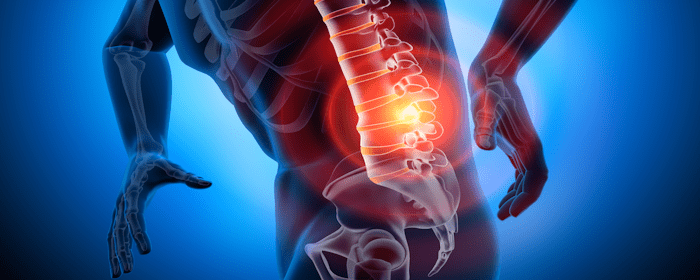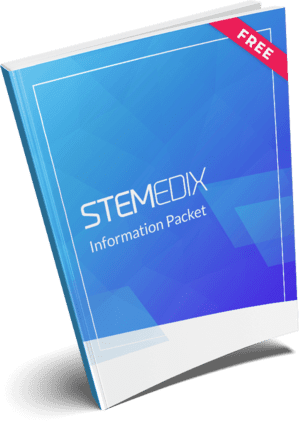
by admin | Jun 5, 2025 | Chronic Pain, Regenerative Medicine, Stem Cell Research, Stem Cell Therapy, Studies
Chronic low back pain (cLBP) remains one of the most prevalent and disabling conditions worldwide, significantly affecting the quality of life and productivity for millions of individuals. For those dealing with discogenic cLBP—pain caused by degeneration or damage to the intervertebral discs—the journey toward lasting relief is often frustrating and unsuccessful. Traditional treatment options frequently fall short, prompting a growing interest in regenerative medicine.
The objective of this study was to evaluate the safety and efficacy of a novel, pragmatic algorithm that both diagnoses and treats cLBP by first identifying annulus fibrosus tears (fissures) in the region of symptoms and then delivering targeted fibrin sealant therapy to support disc repair and functional recovery.
Limitations of Traditional Treatments
Surgical options such as spinal fusions and discectomies have long been used to manage disc-related pain. However, these procedures carry inherent risks and may inadvertently accelerate degeneration. Fusions can increase stress on adjacent discs, while discectomies may weaken the disc structure, making them less than ideal for long-term relief.
Regenerative techniques such as bone marrow aspirate concentrate (BMC) and platelet-rich plasma (PRP) injections offer more conservative alternatives. Still, they lack a crucial component—adhesive properties that enable the treatment to remain within the disc and target the damaged tissue. Without a way to stay in place, these therapies often fail to promote true disc healing.
Evaluating Fibrin Sealant as a Regenerative Option
Fibrin, a natural component of the body’s wound healing process, offers unique advantages as a regenerative therapy. As a bio-adhesive, fibrin can immediately bind to tears in the annulus fibrosus—the tough outer layer of the disc—helping to stabilize the structure and promote tissue regeneration. This property makes fibrin an ideal candidate for treating chronic discogenic pain in a minimally invasive way.
A recent study explored the use of intra-annular injections of allogeneic fibrin sealant to treat patients suffering from chronic low back pain, even after multiple failed interventions. The results are compelling and suggest a promising path forward for individuals living with this difficult condition.
Study Overview and Patient Population
This retrospective cohort study involved 827 patients who had suffered from chronic low back pain—with or without radiculopathy (leg pain due to nerve irritation)—for a minimum of six months. The average duration of symptoms before treatment was 11.2 years, highlighting the severity and chronicity of the condition in the study group.
Participants had already failed at least four invasive treatments, including PRP, BMC, epidural steroid injections, and radiofrequency neurotomies. Some had even undergone failed surgeries such as discectomies and spinal fusions. The mean patient age was 56, and the cohort included 70% men and 30% women.
To qualify, patients underwent MRI and radiographic evaluations to rule out other conditions like spinal fractures, malignancies, severe instability, or significant stenosis. Only those who met strict inclusion criteria were eligible for treatment.
Diagnostic and Treatment Process
The study utilized annulargrams, an imaging technique used during the procedure to identify annular tears within the disc. These diagnostic tools were performed concurrently with the fibrin injections, providing real-time guidance to ensure precise delivery.
Allogeneic fibrin sealant was then injected into the identified fissures in the annulus fibrosus using fluoroscopic imaging to guide placement. Because fibrin adheres directly to the tissue, it integrates with the disc and creates a scaffold for tissue repair.
This innovative approach combines diagnosis and treatment in a single session, improving efficiency and potentially reducing healthcare costs. Future research may examine the cost-effectiveness of this streamlined model.
Promising Patient Outcomes
The results of the study were highly encouraging. Significant improvement was observed at one, two, and three years after the procedure across multiple outcome measures, including the:
- Oswestry Disability Index (ODI)
- Visual Analog Scale (VAS)
- PROMIS® Physical and Mental Health Scores
At the 12-month follow-up, 50% of patients achieved the minimum clinically important difference (MCID) in the ODI score, indicating meaningful functional improvement. Importantly, these positive outcomes were consistent across age, gender, comorbidity, and prior treatment history.
Interestingly, patients who had previously undergone surgery saw even greater relative improvement than those who had not. This finding suggests that fibrin injections may offer an effective second-line treatment for patients who did not benefit from surgical interventions.
Safety and Adverse Events
No severe adverse events or infections were reported in the study, which is consistent with existing literature showing low complication rates from interventional spine procedures. Fibrin’s natural bio-compatibility may contribute to its favorable safety profile.
Given the high safety margin and promising results, fibrin sealant appears to be a well-tolerated and effective treatment option for patients with discogenic low back pain.
Study Limitations and Future Directions
Despite its promising outcomes, the study was not without limitations. It was a retrospective analysis of prospectively collected data, and it lacked a randomized control group. Participants acted as their own controls through pre- and post-treatment comparisons. Additionally, the voluntary nature of treatment selection may have introduced selection bias.
The gender imbalance (30% female, 70% male) also limits the generalizability of results. Future studies should aim for more gender-balanced samples to better understand how the treatment performs across populations.
Patient compliance with follow-up assessments decreased over time, which may have affected the consistency of long-term outcome data. Still, the data were independently collected and analyzed by statisticians using validated tools from the Regenerative Orthobiologics Registry, which adds credibility to the findings.
To strengthen the evidence base, future studies should include randomized controlled trials (RCTs), longer follow-up periods, broader patient populations, and comparative studies against other biologics like PRP and BMC.
A New Path Forward in Regenerative Spine Care
For patients who have struggled with years of chronic low back pain, intra-annular fibrin sealant offers new hope. Its unique adhesive properties allow it to bind securely within the disc, facilitating healing where other treatments have failed. Even in patients with extensive treatment histories, including failed surgeries, fibrin sealant injections demonstrated the ability to restore function and relieve pain.
This study highlights the regenerative potential of harnessing the body’s own healing mechanisms in a minimally invasive way. It also sets the stage for larger clinical trials that can solidify fibrin sealant’s place in the treatment landscape for discogenic cLBP.
Fibrin Sealant Injections: A Breakthrough in Regenerative Treatment for Chronic Discogenic Back Pain
Intra-annular injections of allogeneic fibrin sealant represent a safe, effective, and innovative approach to managing chronic discogenic low back pain and radiculopathy. With improvements documented across both physical and mental health outcomes—and a favorable safety profile—this treatment offers a compelling alternative for patients who have not responded to traditional therapies.
As the field of regenerative medicine continues to evolve, treatments like fibrin sealant provide not only physical relief—but also hope—for those whose lives have been disrupted by chronic back pain.
Source: Pauza K, Boachie-Adjei K, Nguyen JT, Hussey Iv F, Sutton J, Serwaa-Sarfo A, Ercole PM, Wright C, Murrell WD. Long-term Investigation of Annulargrams and Intra-annular Fibrin to Treat Chronic Discogenic Low Back Pain and Radiculopathy: 1-, 2-, and 3-Year Outcome Comparisons of Patients with and without Prior Surgery. Pain Physician. 2024 Nov;27(8):537-553. PMID: 39621982.

by admin | Apr 3, 2025 | Back Pain, Chronic Pain, Stem Cell Research, Stem Cell Therapy
Chronic low back pain is a widespread issue, affecting over 600 million people globally. It is a leading cause of disability, with significant social and economic consequences. In the United States alone, nearly 27 million adults experience back problems, with approximately 19 million seeking treatment. Discogenic lower back pain, which originates from the intervertebral discs, is the most common cause of this condition, accounting for about 39% of cases. Current treatment methods include conservative approaches, surgical procedures, and minimally invasive interventional techniques.
In this study, Navani et al. aimed to compare the safety and effectiveness of PRP and BMC injections for treating chronic low back pain against a control group. The author’s also sought to measure patient satisfaction and monitor the need for further medical intervention, such as hospitalization, emergency room visits, or spinal surgery.
Understanding Intervertebral Disc Degeneration
The intervertebral disc (IVD) is a crucial structure within the spine that helps absorb shock and provides flexibility. It consists of a central area called the nucleus pulposus, which is surrounded by the annulus fibrosus. The disc is located between cartilaginous endplates that regulate metabolism within the IVD. The disc’s central area is characterized by low oxygen levels and a hypoxic environment, which limits the ability for natural cellular repair.
Degeneration of the intervertebral disc, known as intervertebral disc degeneration (IDD), occurs when there is an imbalance between the disc’s ability to regenerate and the breakdown of its structure. Factors such as aging, disease, or injury can speed up the degeneration process, leading to chronic low back pain. Changes in the structure of proteins and collagen within the disc play a significant role in this degeneration, leading to reduced nutrient exchange and increased acidity within the disc, which further hampers cellular repair.
The Role of Inflammation and Pain
When the intervertebral disc begins to degenerate, it creates an environment that encourages inflammation. The disc becomes populated with proinflammatory substances, such as tumor necrosis factor (TNF) and various interleukins, which hinder the disc’s ability to repair itself. These inflammatory molecules also increase the production of enzymes that break down the disc’s structure, causing further damage. Inflammation not only contributes to the physical degradation of the disc but also sensitizes nerve fibers, leading to increased pain.
New Regenerative Treatments: PRP and BMC
Recent advancements in regenerative medicine have introduced novel treatments aimed at healing the degenerated disc rather than simply managing symptoms. Two promising approaches involve using the patient’s own biological materials: platelet-rich plasma (PRP) and bone marrow concentrate (BMC).
- Platelet-Rich Plasma (PRP): This therapy involves extracting a small amount of the patient’s blood, processing it to concentrate the platelets, and then injecting it directly into the degenerated disc. Platelets release growth factors and other bioactive substances that promote tissue healing, reduce inflammation, and encourage new tissue growth.
- Bone Marrow Concentrate (BMC): BMC is obtained by collecting bone marrow from the patient and concentrating it to enrich stem cells and other regenerative cells. These cells have the ability to differentiate into disc-like cells and release anti-inflammatory substances. The use of BMC aims to support the repair of the disc by promoting the formation of new extracellular matrix and reducing inflammation.
Results and Findings
Navani et al.’s showed significant improvement in pain levels and functionality for patients who received PRP or BMC treatments compared to those who did not. Both PRP and BMC therapies were effective in reducing pain, improving function, and enhancing quality of life over a 12-month period. Although there was no significant difference in outcomes between PRP and BMC, both treatments outperformed the placebo. No complications or adverse effects were reported during the study, and none of the participants required surgery, emergency care, or hospitalization related to their treatment.
Limitations of the Study
The study had some limitations, including a small number of participants and variability in the concentration of cells used in the BMC treatments. The differences in harvesting techniques, participant characteristics, and clinical settings may have influenced the results. Additionally, the study’s open-label design could have introduced bias in reporting outcomes.
Factors Influencing Treatment Success
The effectiveness of PRP and BMC treatments can be influenced by several factors, such as the method used to collect bone marrow, the equipment used, and the individual characteristics of the patient, including age, gender, and overall health. Variability in the number of regenerative cells collected may impact the treatment’s ability to repair the disc.
Future Research Directions
More research is needed to determine the optimal number of cells for BMC treatments and to better understand how different biological components within PRP and BMC contribute to the healing process. Exploring multi-targeted approaches that address various structures in the spine, such as facet joints and ligaments, may also enhance treatment outcomes for chronic low back pain.
PRP and BMC for Chronic Low Back Pain
PRP and BMC represent promising regenerative treatment options for chronic low back pain. They aim to repair the damaged intervertebral disc and provide relief without the need for invasive surgical procedures. While both therapies show significant potential, the authors indicatefurther studies are needed to refine the techniques, understand the variability in treatment responses, and establish best practices for their use.
Source: Navani A, Ambach M, Calodney A, Rosenthal R, Li G, Mahoney CB, Everts PA. The Safety and Effectiveness of Orthobiologic Injections for Discogenic Chronic Low Back Pain: A Multicenter Prospective, Crossover, Randomized Controlled Trial with 12 Months Follow-up. Pain Physician. 2024 Jan;27(1):E65-E77. PMID: 38285032.

by Stemedix | Jun 10, 2024 | Back Pain, Chronic Pain, Health Awareness, Pain Management, Regenerative Medicine, Stem Cell Research, Stem Cell Therapy
“Back pain” is a general term that can mean many different things. From nerve pain to strained back muscles, there are various reasons your back might hurt. Dealing with chronic back pain is mentally and physically exhausting, and you deserve relief. The first step in properly managing your chronic back pain is to know what’s behind it. Use this guide to shed some light on the potential root cause of back pain, and available treatments for your comfort.
Why Does Your Back Hurt?
If you’ve experienced severe back pain before, your first question is probably, “Why?” It might feel like you’re willing to do anything to stop the pain.
Unfortunately, there isn’t one universal cause for severe back pain. If you’re struggling with it, it’s time to examine what might be causing it.
Some of the circumstances that can cause chronic back pain include:
- Neurodegenerative disease (like MS or ALS)
- Car accidents
- Sports injuries
- Musculoskeletal problems
- Spinal alignment issues
- Spinal cord infections and diseases
- Orthopedic (bone) problems
- Strained back muscles
- Poor posture
- Neuropathic pain
These are just a few of the debilitating problems you may be dealing with. A qualified healthcare professional can guide you to the proper diagnosis.
Muscular Back Pain
Your back is full of muscles that help you sit, stand, and move around. When one of these muscles’ experiences overuse, stress, or strain, you’ll feel it in major ways.
Movement Injuries
If you twist, sleep, or lift something in the wrong manner, you could end up with a strained back muscle. This will feel different than regular soreness after a back workout.
Sports injuries can affect your back muscles. Especially in contact sports and other intense activities, your back faces many risks each time you play. The more conditioned and flexible you are, the less likely you are to get an overuse or muscle strain injury.
Stress
Psychological stress can also lead to muscular back pain. When you’re stressed, your body tenses up in ways you may not even notice. The muscles in your back may become stiff, strained, or generally uncomfortable as a result.
Lack of Sleep
You also tend to lose sleep when you’re undergoing lots of mental stress. Your body uses sleep as the primary time to repair your muscles and make them stronger. If you aren’t getting enough rest at night or you work the third shift, your back muscles are more prone to pain and injury.
Neurological Back Problems
Your nervous system sends messages to all parts of your body using electrical impulses. The central hub for all of the nerves that extend outward from your body is your spinal cord. Neurological diseases and spinal cord injuries can impair your back in surprising ways.
Neuropathic Pain
Neuropathy develops when nerves throughout your body become damaged in some way. This is a common symptom of neurodegenerative diseases like MS. When your peripheral nerves are damaged, they can’t communicate with your brain properly, leading to strange sensations and pain.
Neuropathic back pain may feel like numbness, tingling, burning, “pins and needles,” or sharp excruciating pains. If you suffer from a neurological health condition, there’s a solid chance your back pain is related.
Car Accidents and Spine Injuries
Automobile accidents exert a lot of force and impact on your body all at once. When you get into an accident, even if it’s minor, your back and neck muscles can experience whiplash. In extreme cases, car accidents can also cause spinal injuries.
Spinal cord injuries are very serious. Your spinal cord protects your nerves and secures their pathway to your brain. Chronic back pain, numbness, and loss of limb function could indicate an underlying spinal injury.
Herniated Discs and Pinched Nerves
If one of the cartilage discs between your vertebrae becomes dislodged, it can press on the nerves surrounding it. A herniated disc can spell trouble for your mobility, limb functions, and comfort for years.
Vertebral problems can also pinch the nerves in your back, which results in the same thing — long-lasting sharp back pain. Discomfort from a pinched nerve will likely feel sudden, sharp, and breathtaking.
Lifestyle Factors and Back Pain
Certain aspects of your lifestyle may be causing your chronic back pain and soreness. These factors aren’t considered diseases themselves, but they can lead to chronic health problems that become long-term conditions.
The following are risk factors for chronic back pain:
- Obesity
- Poor posture
- Sedentary lifestyle
- Overtraining
- Poor nutrition
- Labor-intensive jobs
- Improper lifting techniques
Whenever possible, you should avoid these risks. Steps like wearing a posture corrector and lifting heavy objects with your leg muscles can help prevent chronic back problems.
Solving Your Pain: Back Treatment Options
You don’t have to live in unbearable pain forever. You have options when it comes to severe back pain treatment. Every person has a different threshold for pain, and you may prefer less invasive, more natural treatments than someone else.
Medication
Pain medication will block your brain from receiving pain signals in your back. Medication is a valid option for people struggling to function due to chronic back problems. However, most medications don’t treat the root cause of your back pain. It’s a good idea to consider other treatments along with medication.
Surgery
Back surgery is intense, invasive, and risky, but for some people, it’s the best and only option. Severe spinal cord injuries and disc herniations may require immediate surgery to correct the problem. After surgery, you’ll likely be instructed to perform back exercises to improve your mobility.
Regenerative Medicine
Regenerative medicine, also known as stem cell therapy, for back pain may offer an innovative and cutting-edge option. By utilizing human-derived stem cells to repair and renew damaged tissues throughout your body, these “blank” cells can form into almost any type of specialized cell, making them a potential effective modality to help manage and heal chronic back pain.
Evaluating Your Options
It may take a few different interventions before you experience back pain relief. What’s important is that you don’t give up. With the proper treatment, you can experience mild to intense relief and continue on with your life. Medicine is always improving, and you have more options than ever before.

by Stemedix | Nov 6, 2023 | Multiple Sclerosis, Autoimmune, Chronic Pain, Musculoskeletal, Stem Cell Research, Stem Cell Therapy, Studies
Around the world, an estimated 1.8 million people live with multiple sclerosis. This autoimmune condition is chronic and can affect your life expectancy. The right treatment options, however, may impact the outcome you can expect. Learn about multiple sclerosis life expectancy and how the latest treatments help.
Understanding Multiple Sclerosis
Multiple sclerosis is a chronic autoimmune condition in which your immune system mistakenly attacks the sheaths that surround and protect the nerves in the spinal cord and brain, called the myelin. A damaged myelin interferes with the signals your brain sends to other parts of your body.
Symptoms of multiple sclerosis include:
- Fatigue
- Muscle weakness
- Muscle spasms
- Changes in gait
- Loss of coordination or balance
- Numbness or tingling in arms or legs
The causes of multiple sclerosis vary and are not always clear. They include being exposed to certain viruses or bacteria. People who had particular infections, like Epstein-Barr exposure, are more likely to develop MS. Other causes may be your environment, genetic mutations, and even how your immune system functions.
Diagnosing Multiple Sclerosis
Getting an accurate diagnosis is one of the most crucial steps if you have multiple sclerosis. A definite test has not been developed for MS, but the symptoms you experience will lead your doctor to perform a physical exam, take blood, and get imaging tests like MRIs.
MRIs can catch any lesions in your spinal cord or brain. These lesions develop as the disease damages the myelin. Your doctor may also perform a spinal tap.
If these tests don’t offer a definite diagnosis, you may have to undergo an evoked potentials test. This test checks for nerve damage by measuring electrical activity in the spinal cord and brain.
Multiple Sclerosis Life Expectancy: Factors to Consider
Newly diagnosed patients with MS who don’t have severe disabilities have a life expectancy of 30 years or more, but lots of factors play a role in determining this number. Your unique circumstances impact life expectancy.
Disability Status
The Expanded Disability Status Scale (EDSS) is an important factor for healthcare providers attempting to provide an estimated life expectancy. The EDSS measures the level of disability in patients with MS. Everything from loss of independent ambulation to cognitive function is measured to provide the EDSS score.
Mental Health
People with MS who experience mental health concerns like depression and anxiety may have a lower life expectancy. This is because mental health significantly impacts physical health and can even worsen the symptoms of MS.
Compliance With Therapeutic Regimen
Following treatments as required impacts how the disease progresses, which then impacts your life expectancy. The type of treatment you receive is a factor.
Lifestyle Changes to Improve Life Expectancy
For many people with MS, making some lifestyle changes helps impact their life expectancy. Diet is one of the changes.
Following a healthy diet helps you manage symptoms while also improving your overall health. For MS patients, decreasing the intake of saturated fats and instead consuming omega-3 polyunsaturated fatty acids helps prevent myelin loss in the central nervous system.
Adding stress management techniques to your life is another change you can make. Stress makes MS symptoms worse. Trying breathing exercises, meditation, or turning to a therapist. These strategies can all improve your stress levels and impact your overall health.
You also want to add physical exercise to your routine. Physical exercise may help slow down disease progression. Aerobic exercise may be able to decrease inflammation. It can also aid in decreasing depression and other mental health concerns that are a result of MS.
Staying at a healthy weight is also vital for increasing life expectancy. People with MS have a higher risk of malnutrition, and they are more prone to being both underweight and overweight. Adding exercise to your day and improving your food choices will help you correct any nutritional issues you have, leading to better overall health.
Getting better sleep is another important change you can make, as well as quitting any form of nicotine you may use. Smoking increases inflammation, which can make MS symptoms worse.
How Regenerative Medicine Can Help
For people with MS, one promising treatment option is regenerative treatments like stem cell therapy. More people are turning to stem cell therapy because it may be able to decrease inflammation and improve symptoms with minimally invasive measures.
Stem cell therapy uses stem cells, which are the cells that differentiate into the many types of cells in the body. For multiple sclerosis, mesenchymal stem cells are particularly useful because of their ability to repair myelin. They may also have a positive impact on the immune system.
For this type of treatment, your healthcare provider removes stem cells from your bone marrow or fat, preparing them for an injection to reintroduce them into the body. Stem cell therapy is a great option for those searching for minimally invasive treatments that don’t require a long recovery process.
Stem cell therapy gets right to the cause of MS symptoms: the damage of myelin. Unlike other treatment options, studies have shown that regenerative medicine has the potential to help with symptom management, slowing down progression, and provide a better quality of life.
It is also a treatment option that may be less likely to cause side effects because the stem cells usually come from your body.
Living With Multiple Sclerosis
Getting a diagnosis of multiple sclerosis can be stressful, but it’s crucial to know that many people with the condition live full and happy lives. Advances in medicine have made it easier than ever to extend your life expectancy with conditions like multiple sclerosis, especially if you receive an early diagnosis.
Stem cell therapy and other forms of regenerative medicine work to offer you the help you need while targeting the cause of the disease. By combining stem cell therapy with lifestyle changes like exercising and eating better, you may be giving your body the ability to slow down the disease’s progression while improving your overall health.

by admin | May 26, 2023 | Health Awareness, Chronic Pain
Many health conditions and lifestyle factors lead to ongoing inflammation within the body. When you have widespread inflammation, it can lead to chronic pain, aches, and other health concerns.
If you want to lower inflammation and feel better overall, you may benefit from an anti-inflammatory diet. Learn more about the anti-inflammatory diet and what it includes below.
The Anti-Inflammatory Diet
While certain foods can trigger inflammation, others can reduce it. The anti-inflammatory diet limits inflammatory triggers and focuses primarily on foods that can lower inflammation.
Foods that Trigger Inflammation
Anti-inflammatory diets limit the following foods that are considered inflammation triggers:
- Red meat
- Processed foods
- Sugar
- Fried foods
- White bread
- Cookies, candy, and ice cream
- High sodium foods
- Alcohol
When these foods are highly restricted or altogether eliminated, it can lead to lower inflammation levels throughout the body.
Foods that Reduce Inflammation
While the anti-inflammatory diet restricts foods that are triggered, it calls for an increase in foods that can reduce inflammation. These foods include:
- Oily fish (tuna, salmon)
- Berries
- Green leafy vegetables
- Nuts and seeds
- Beans
- Olive oil
- Probiotics
- Tea
These anti-inflammatory foods are high in antioxidants and other properties that can decrease inflammation. When your diet consists mostly of these foods, you can see a significant reduction in widespread inflammation, which may lead to a resolution of chronic pain and other symptoms.
Starting an Anti-Inflammatory Diet
If you struggle with chronic inflammation and want to try the anti-inflammatory diet, always speak with your medical team beforehand. Making major dietary changes is very impactful and should be discussed with your doctor in advance.
It is important to make sure that the anti-inflammatory diet is a healthy fit for any underlying conditions you already have. It is also important to ensure you are healthy enough to make a major dietary change.

by admin | Mar 31, 2023 | Chronic Pain, Health Awareness
Chronic pain can make even the simplest daily tasks feel impossible. However, exercise can help you manage some of your symptoms by providing pain relief and boosting mobility. Try some of these exercises to gain control over your chronic pain and enjoy a better quality of life.
Stretches
Stretching allows your muscles to relax and relieves painful tension that accumulates over time.
If you suffer from lower back pain, try the following stretch:
- Lie down on the floor on your back
- Raise both knees toward your chest
- Wrap your arms around your knees to pull them in closer
- Feel the stretch in your lower back muscles as you rock back and forth with your knees near your chest
- Set one foot on the floor and move your other foot so that your ankle is resting near your knee
- Pull on the back of your leg that has your foot resting on the floor
This action stretches your glutes and lower back, and it can reduce stiffness and pain when practiced regularly.
Outdoor Walking
Walking can reduce chronic pain by exercising your leg muscles and improving circulation. And being surrounded by nature can offer additional physical and mental health benefits.
Take a walk outdoors once a day to relieve some of your pain. You will benefit from sun exposure as well as the low-intensity movement that comes with walking.
If you are unable to walk outdoors, you can use an indoor treadmill to boost your blood flow and get moving each day.
Swimming
Swimming is a popular low-impact exercise for many people who struggle with chronic pain. When you swim, your joints can remain comfortable as you move fluidly through the water.
Low-impact cardio exercises like swimming get your blood pumping and your muscles moving with less strain on your body. Take a dip in the water next time you feel like exercising.
Relieve Pain Naturally with Daily Exercises
If you practice these techniques daily or weekly, you may see great relief from your symptoms. Chronic pain can be debilitating, but with regular exercise, you can start healing from the inside out.







 St. Petersburg, Florida
St. Petersburg, Florida
